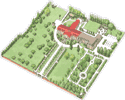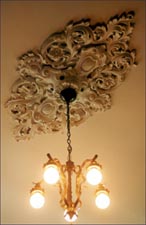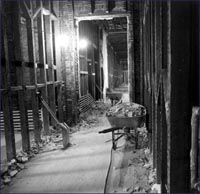
| PLACES | |||||||
| Chapel | |||||||
| Humboldt Gates | |||||||
| Academy Green | |||||||
| Arboretum | |||||||
| Former Cemetery | |||||||
| 1871 Building | |||||||
| Convent | |||||||
| Interpretive Centre | |||||||
|
|||||||
| 1910 Addition | |||||||
| Auditorium | |||||||
| Orchard | |||||||
| Novitiate Garden | |||||||
| Courtyard | |||||||
 |
|||||||
|
click on map for
larger view |
|
When the historic
restoration of this room began, it was the job of the painters to
study the woodwork. They needed to be able to reproduce the texture
of the painted wood grain, which was originally used to give the
inexpensive wood trim in the parlours and entrance area the appearance
of oak. Dan Evans, the foreman from Canadian Paint and Paper, took
courses in Vancouver to acquire knowledge of the woodgraining techniques.
Brushes, special woodgraining tools and metal combs were used in
this craft, to layer colour. Including the other areas of the Interpretive
Centre, almost 400 square metres of grained wood trim and panelling
were carefully restored. The painters felt that the painting technique
itself was not a challenge, but that replicating the brush strokes
of the historic painters was very difficult. Dan thought that by
"trying to get into the heads of the guys who did it originally",
he would be able to capture their woodgraining style.
The plaster
ceiling in the Red Parlour had suffered damage from the years that
St. Ann's experienced neglect, after the closure of the school.
The building had also shifted over the years, warping the shape
of the walls and ceiling. The central medallions, which were the
mouldings around the light fixture, and the floral work in the shape
of dogwood flowers, were broken, had missing pieces and were water
damaged. The plasterers made rubber moulds of the plaster decorations
and replicated pieces to repair the damaged areas. This was a job
where modern tools were utilized in a traditional craft; not many
people still do plaster work in modern buildings. Other differences
between the traditional and restored plaster work included the rubber
moulds to shape the decorative pieces, instead of gelatine moulds.
Lime and plaster of Paris were used to attach plaster work to the
ceiling.
This room has
been used by many people, for many diverse purposes. When the Academy
closed and it was no longer a formal parlour, it became a board
room, for the meetings of the Provincial Capital Commission. It
has been used as a set, for the filming of cinematic productions.
Currently, it is open to visitors to the Interpretive Centre at
St. Ann's Academy. Guests can sit quietly, gazing at the paintings,
or, during the Christmas Season, they can sip hot cider after choir
concerts in the chapel and leave gifts for children in need, under
the Christmas tree. This parlour enjoys its modern uses! More
on the Interpretive Centre
Contact
St. Anns Academy at stanns.academy@gems2.gov.bc.ca
Contact the Webmaster at zeroone@zeroonedesign.com
|

